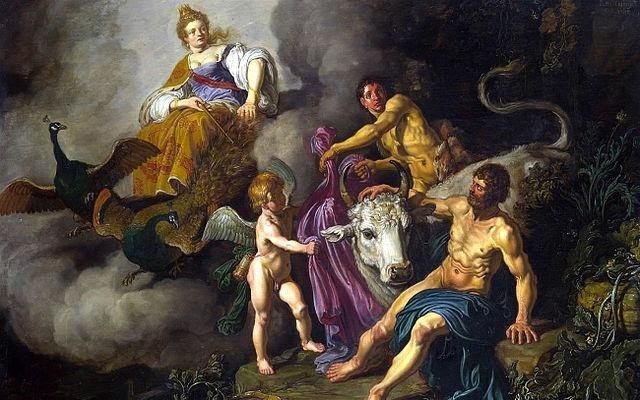Etymology of and history behind June
by Caroline Simpson
Whether you subscribe to the season starting on the first day of the month or at the solstice, June is the start of the wet, windy, cold winter season in New Zealand. It is hardly a common time for a wedding, but talking to Ryn Yee, our newsletter editor, I learnt that June is considered an excellent month for a wedding in the United States. It is not just the start of the northern summer that makes it popular, though, as I discovered.
In the Roman republican calendar, Junius had been the fourth month, sacred to the goddess Juno. When the Julian calendar was introduced around 40 BCE, Junius became the sixth month due to the addition of January and February. In Roman mythology, Juno was the wife and sister of Jupiter (things were different back then), known as the protector of women, marriage and childbirth. Perhaps couples thought marrying in Juno’s month would bring them happiness. Certainly, June was regarded by Romans as a favoured month for marrying.
More practical issues suggest why the tradition continued. Brides marrying in medieval times may have smelled sweeter because people were more likely to bathe in the summer months. And June brides were more likely to be able to help with harvest the following year if conception came soon after the marriage.
Whatever the reason, the custom was transported to America and the fine June weather kept it alive. June weddings even inspired June Bride, a 1948 movie starring Bette Davis, and the song June Bride from the 1954 musical Seven Brides for Seven Brothers.
Disappointingly, it has been suggested that more recently in the USA June was a popular wedding month for tax reasons because careful date planning could result in a tax refund.
As for Juno who sparked some of these traditions, she had troubles of her own, if Bulfinch’s Mythology is to be believed. Her husband, Jupiter, had been flirting with the beautiful Io down by the river. He saw his wife coming and transformed his mistress into a heifer to hide her from Juno. But Juno was more cunning, and the tale tells of how she manoeuvred her husband into handing over the heifer and her subsequent persecution of Io. A role model for brides the world over?
On the northern winter solstice of 2018, the spacecraft Juno flew in for a close look at Io, one of the moons of Jupiter. It was her seventeenth fly-by of the giant planet. Who says scientists do not have a sense of humour?

Image: Juno Discovering Jupiter with Io by Pieter Lastman
Bibliography:
Britannica, The Editors of Encyclopaedia. 2019. Encyclopaedia Britannica. July 1. Accessed May 21, 2020. www.britannica.com/science/Julian-calendar.
Britannica, The Editors of Encyclopaedia. 2011. Encyclopaedia Britannica. April 26. Accessed May 21, 2020. www.britannica.com/science/Roman-republican-calendar.
Bulfinch, Thomas. 1968. Bulfinch’s Mythology. Middlesex: The Hamlyn Publishing Group Limited.
Dent, Susie, ed. 2012. Brewer’s Dictionary of Phrase and Fable, 19th edition. London: Chambers Harrap Publishers Ltd.
Schultz, Christine. 2017. The Old Farmers Almanac. August 22. Accessed May 21, 2020. www.almanac.com/content/wedding-traditions-customs-and-etiquette.
2007. Shorter Oxford English Dictionary, 6th edition. New York: Oxford University Press Inc.
Southwest Research Institute. 2019. Science Daily. January 2. Accessed May 21, 2020. www.sciencedaily.com/releases/2019/01/190102112852.htm.
Schultz, Christine. 2017. The Old Farmers Almanac. August 22. Accessed May 21, 2020. www.almanac.com/content/wedding-traditions-customs-and-etiquette.
2007. Shorter Oxford English Dictionary, 6th edition. New York: Oxford University Press Inc.
Southwest Research Institute. 2019. Science Daily. January 2. Accessed May 21, 2020. www.sciencedaily.com/releases/2019/01/190102112852.htm.https://www.almanac.com/
Schultz, Christine. 2017. The Old Farmers Almanac. August 22. Accessed May 21, 2020. www.almanac.com/content/wedding-traditions-customs-and-etiquette.
2007. Shorter Oxford English Dictionary, 6th edition. New York: Oxford University Press Inc.
Southwest Research Institute. 2019. Science Daily. January 2. Accessed May 21, 2020. www.sciencedaily.com/releases/2019/01/190102112852.htm.
Caroline Simpson is a freelance editor and EdANZ Branch President and can be contacted at edanz.president@iped-editors.org.
